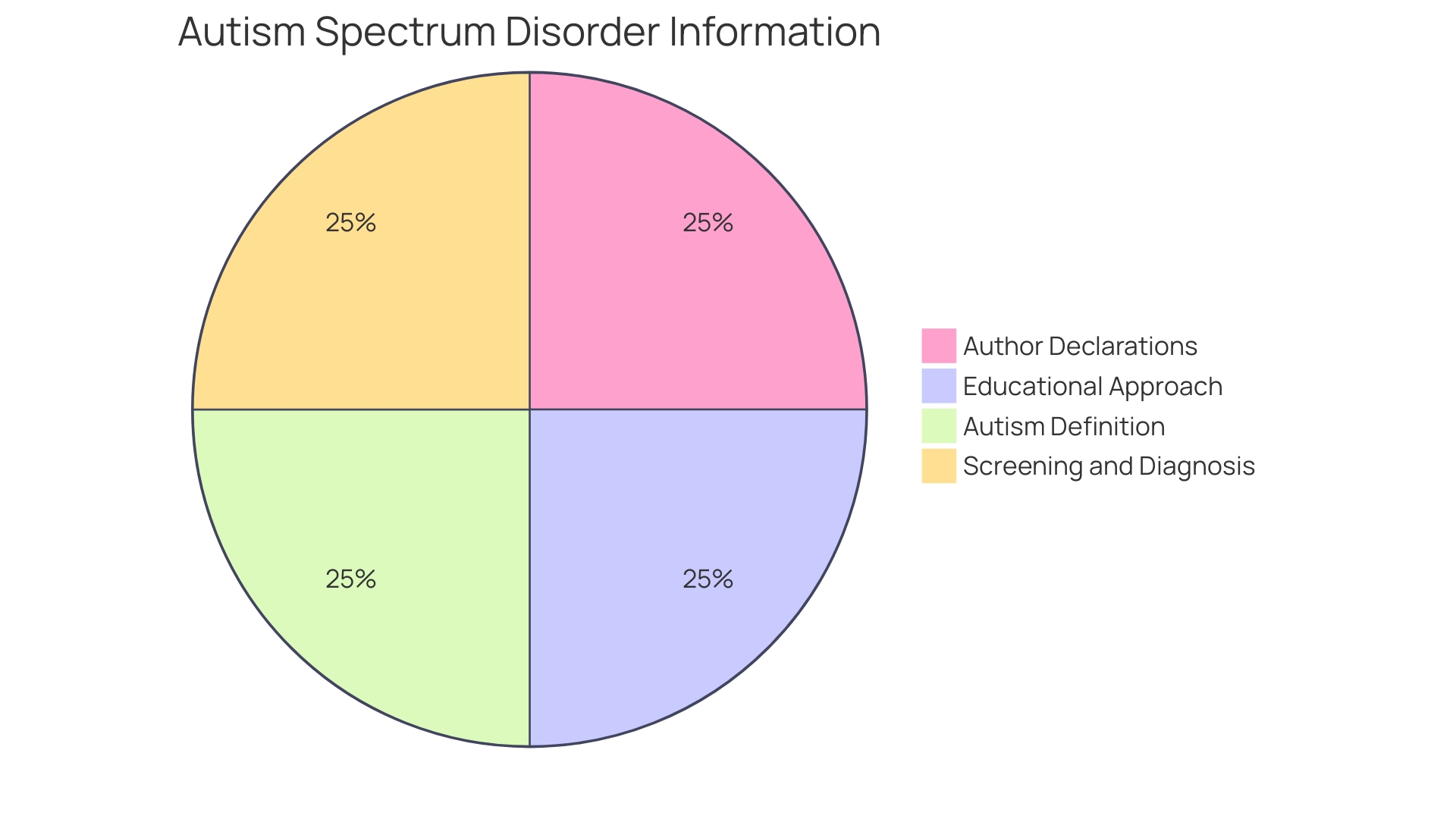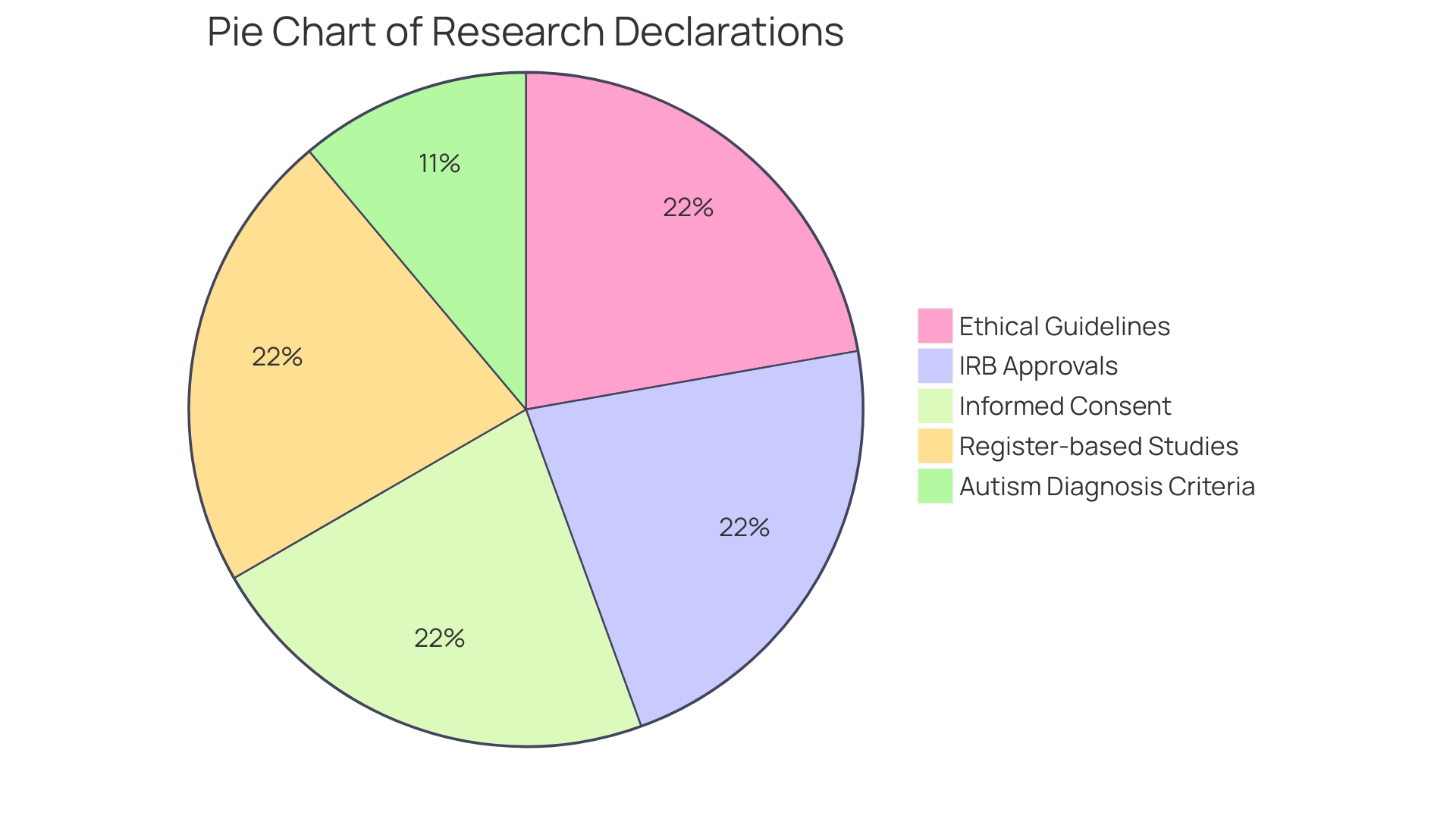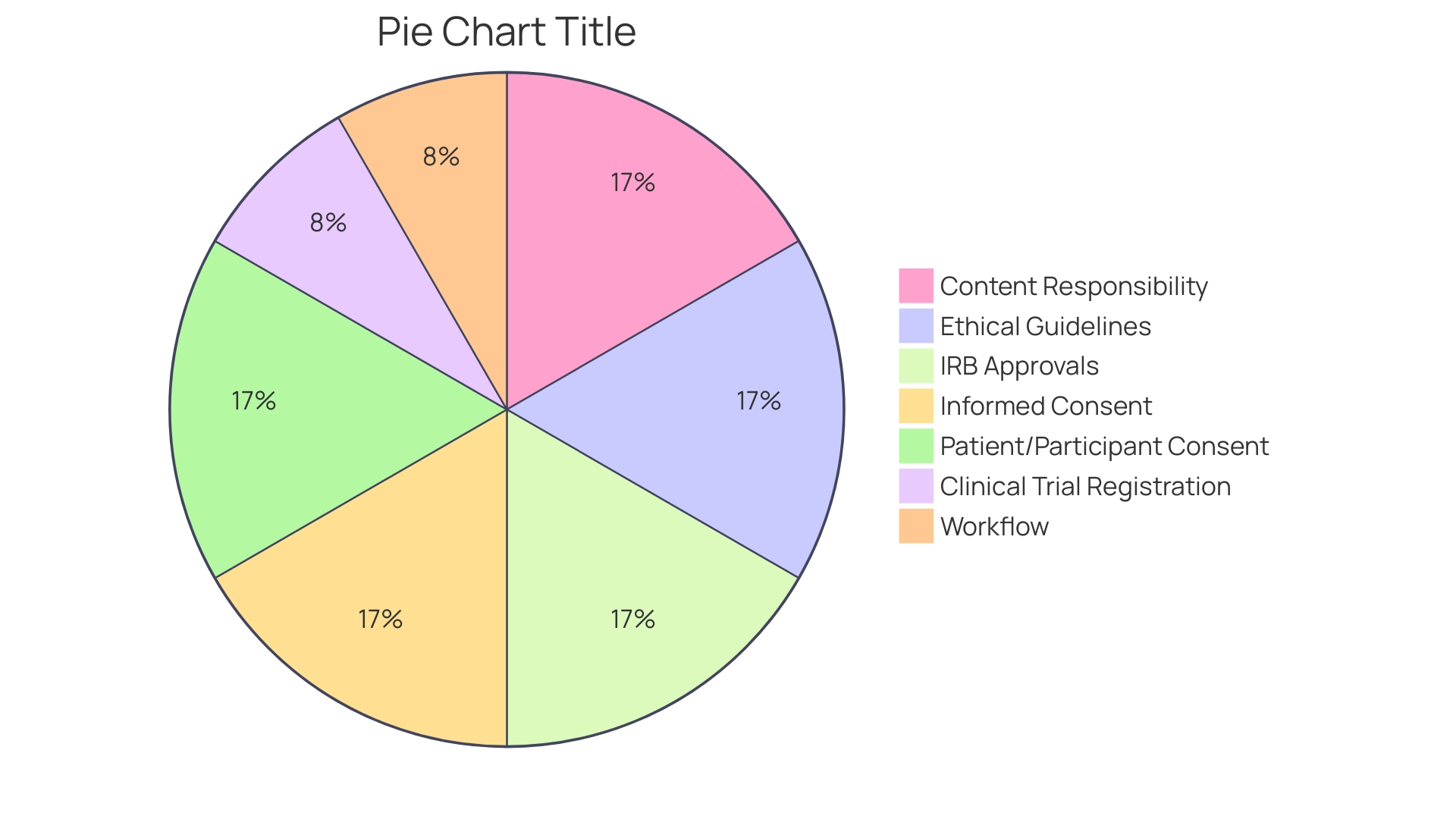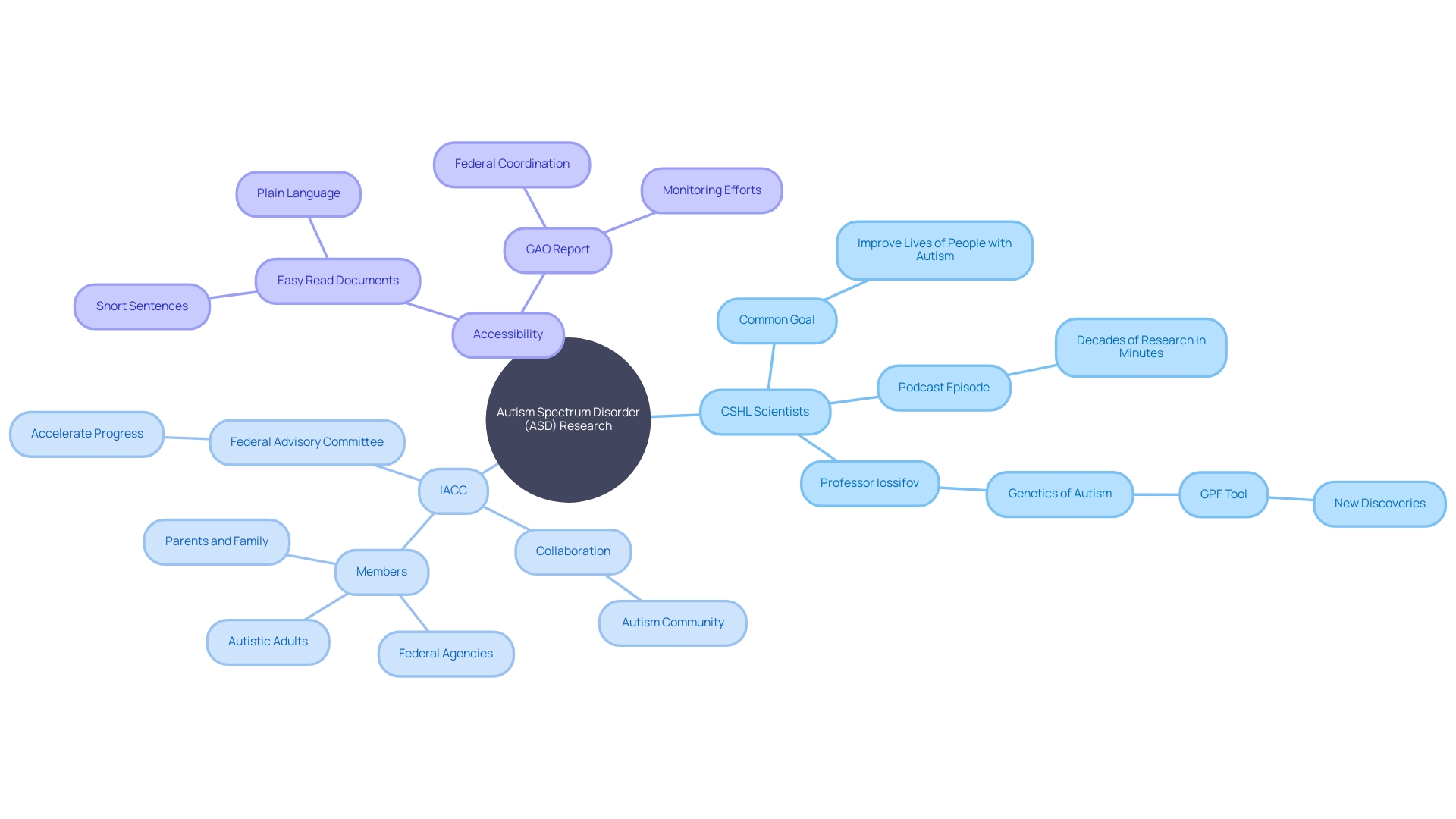Introduction
Autism Spectrum Disorder (ASD) poses a complex challenge that affects various aspects of a person's life. While the exact causes of ASD are still not fully understood, scientists agree that genetics play a significant role. Pioneering research, led by Professor Iossifov and utilizing tools like Genotypes and Phenotypes in Families (GPF), is shedding light on the genetic underpinnings of autism, offering hope for improved understanding and targeted therapies.
These studies adhere to strict ethical standards and emphasize the importance of considering both genetic and environmental factors in the context of ASD. As our comprehension of the genetic factors of autism evolves, it becomes increasingly clear that unlocking these mysteries can lead to better support for individuals with ASD and their families.
The Genetic Basis of Autism
Autism Spectrum Disorder (ASD) presents a multifaceted challenge affecting social skills, communication, and behavior. While its exact origins are elusive, the consensus in the scientific community points towards a significant genetic component. Pioneering research, such as the work led by Professor Iossifov and the Genotypes and Phenotypes in Families (GPF) tool, continues to shed light on the genetic underpinnings of autism, promising to enhance our understanding and potentially guide targeted therapies.
Studies adhering to strict ethical standards, like those approved by the Danish Data Protection Agency and registered with ICMJE-approved registries, bolster the credibility and reliability of this research. Insight into the genetic factors of autism has evolved substantially since its first definition in the DSM-III, reflecting broader diagnostic criteria and greater awareness. This evolution mirrors the increase in prevalence rates over time and underscores the importance of considering both genetic and environmental factors in the context of ASD.

Heritability of Autism: Twin and Family Studies
Research in the field of genetics has made it increasingly clear that autism spectrum disorder (ASD) is influenced by hereditary factors. This is particularly evident from twin and family studies, which reveal that identical twins have a much higher likelihood of both being affected by ASD compared to fraternal twins, indicating a strong genetic link. Moreover, individuals with relatives who have autism are at a greater risk of developing the condition themselves.
These patterns underscore the significance of genetics in understanding autism.
At institutions like Cold Spring Harbor Laboratory (CSHL), innovative tools like Genotypes and Phenotypes in Families (GPF) are being developed to delve deeper into the genetic underpinnings of ASD. Pioneered by Professor Iossifov, who initially had a background in computer science, this tool represents the cross-disciplinary efforts being made in autism research.
Further emphasizing the genetic aspect of autism, recent findings suggest that the balance between different types of neurons in the brain, excitatory and inhibitory, could play a role in the development of ASD. Discrepancies in the number or function of these neurons may be linked to the disorder, offering another avenue for scientific investigation.
It's important to note that the body of research adheres to strict ethical standards, with necessary approvals from oversight bodies and informed consent procedures in place, ensuring the integrity and responsibility of the studies conducted. As the scientific community continues to explore the genetic factors of autism, these ethical considerations remain paramount, providing a solid foundation for future discoveries that could lead to enhanced understanding and support for individuals with ASD and their families.

Common and Rare Genetic Variations in Autism
Genetic research into autism spectrum disorder (ASD) has progressed significantly, shedding light on the intricate genetic components that may contribute to its development. Investigations have pinpointed a range of genetic variations, including widespread single nucleotide polymorphisms (SNPs) and the more scarce copy number variations (CNVs) and de novo mutations. SNPs, while individually exerting minor effects, cumulatively can heighten the likelihood of ASD.
On the other hand, CNVs and de novo mutations, although less common, can play a pivotal role. Such genetic anomalies can result in the deletion or duplication of DNA segments, leading to a range of developmental challenges associated with autism. The interplay of these diverse genetic factors underscores the complexity of autism's genetic underpinnings.
New methodologies, such as transport-based morphometry (TBM), are now being employed to discern patterns in brain structure that correlate with these genetic variations. This cutting-edge approach paves the way for a deeper understanding of the link between brain morphology and genetic alterations in autism, offering a promising avenue for tailored interventions and supports.

Recent Study Findings: New Genetic Clues in Multiplex Families
Pioneering research has set its sights on the genealogy of autism, particularly within multiplex families where the occurrence of autism spectrum disorder (ASD) is seen in more than one family member. The meticulous work of scientists has shed light on unique gene mutations and rare genetic variants that tend to be more frequent in these families compared to the general populace. For instance, the Baby Siblings Research Consortium, which unites over 20 international research groups, has advanced our understanding of autism's recurrence within families through their large-scale studies, spanning across North America and Europe.
Their work not only reaffirms previous findings but also enriches our knowledge of autism's genetic landscape.
This concerted effort is underpinned by a commitment to ethical research practices, as evidenced by the necessary approvals from the Danish Data Protection Agency and adherence to all relevant guidelines. Such studies are crucial as they unravel the complexities of autism's genetic underpinnings.
One of the trailblazers in this domain, Professor Iossifov, has crafted innovative tools like the Genotypes and Phenotypes in Families (GPF), which herald a new frontier in decoding the genetic intricacies of autism. His transition from a computer science background to the forefront of computational biology and genetic research exemplifies the interdisciplinary approach required to tackle such a multifaceted condition.
The insights gleaned from these studies are not merely academic; they carry the potential to transform the lives of individuals with autism and their families. By deepening our genetic comprehension, we pave the way for more targeted interventions and support that can significantly improve quality of life. As we continue to peel back the layers of genetic influence on autism, the commitment to ethical, informed, and collaborative research remains steadfast, ensuring that each discovery is a step towards a more understanding and supportive future for those affected by ASD.

Polygenic Risk and the Role of Language Delay
Polygenic risk scores (PRS) are revolutionizing our understanding of the genetic predispositions to autism spectrum disorder (ASD). By analyzing the combined influence of various genetic variants, these scores provide insight into an individual's likelihood of developing ASD. In parallel, the connection between language development delays and genetic risks for autism has drawn significant attention from the research community.
Children typically begin speaking their first words around the age of one, and by two, their vocabulary rapidly expands. However, it's the individual variations in this developmental milestone that hint at the underlying genetic complexities.
Beate St Pourcain, a senior researcher, emphasizes the genetic component in language development, revealing that our genetic code can influence this crucial learning phase. To delve deeper into this relationship, a genome-wide meta-analysis study of vocabulary size in infants and toddlers was conducted, utilizing data from 17,298 children across three language backgrounds. This research not only aids in mapping the genetic foundations of language acquisition but also underscores the importance of early detection and tailored interventions for children with ASD.
The implications of these findings are far-reaching. A recent global project, initially focused on Parkinson's disease, has highlighted the significance of genetic research across diverse populations. Spearheaded by researchers like Sara Bandrés Ciga and her team, the initiative emphasizes collaboration and knowledge-sharing among local groups collecting genetic samples, ensuring that these efforts directly benefit the participants and contribute to a broader understanding of genetic influences on conditions like ASD.
The richness of language development in children and its genetic underpinnings present a complex tapestry. As we unravel this intricate link, we open doors to personalized approaches that recognize the unique genetic profiles of individuals with ASD. This research not only sheds light on the genetic factors of autism but also advocates for the potential benefits of bilingualism, challenging the misconceptions that have historically advised against it for autistic children.
The growing evidence suggests that bilingualism does not hinder, and may even enhance, cognitive development in autistic individuals, providing them with valuable social and cultural connections.
Implications for Diagnosis and Understanding of Autism
Unraveling the genetic intricacies of autism spectrum disorder (ASD) is more than an academic pursuit—it's a key to unlocking personalized care and early intervention. Pioneering efforts, like those at Cold Spring Harbor Laboratory (CSHL) led by Professor Iossifov, have resulted in innovative tools such as Genotypes and Phenotypes in Families (GPF). This tool heralds a future where researchers can delve deeper into the genetic roots of ASD, opening avenues for new discoveries.
With the backing of robust ethical guidelines and necessary approvals, studies like those approved by the Danish Data Protection Agency ensure patient confidentiality and compliance with ethical standards. This meticulous approach to research paves the way for genetic testing and screening to become a cornerstone of ASD diagnosis and treatment.
The importance of such advancements cannot be overstated. Organizations like The Autism Community in Action (TACA) and NeuroQure are already addressing the urgent need for early, accurate ASD diagnosis. Their work emphasizes that the sooner behavioral therapy can begin, the more significant the improvement in a child's life, challenging current diagnostic methods that may delay or miss the identification of ASD.
This is not just a scientific journey but a mission fueled by a desire to enhance the well-being of individuals with ASD and their families, as shared by researchers and advocates alike. The progress in genetic research is a beacon of hope, signaling a move towards more timely and tailored interventions that could transform lives.
Environmental and Epigenetic Factors Interacting with Genetics
Autism spectrum disorder (ASD) is a complex condition influenced by both genetic makeup and environmental exposures. While genetics provide the blueprint, environmental factors can significantly impact how these genetic patterns are expressed. For instance, prenatal exposure to certain pharmaceuticals or maternal infections during pregnancy can amplify the risk of a child developing ASD.
Moreover, epigenetic mechanisms, which change gene expression without altering the DNA sequence, are increasingly recognized in the context of autism.
A compelling illustration of the intricate relationship between genetics and environment comes from a study published in the Journal of Personalized Medicine involving four-year-old dizygotic twins with severe ASD. Despite being fraternal twins with different genetic codes, both required substantial support, suggesting that non-genetic factors also played a part in their condition. Indeed, a personalized, non-pharmacological approach by a multidisciplinary team significantly mitigated their ASD symptoms, pointing to the potential benefits of considering both genetic and environmental aspects in management strategies.
Furthermore, recent statistics show ASD is quite prevalent, affecting approximately 1 in every 50 to 60 children. The disorder's complexity is underlined by the diverse genetic mutations associated with ASD, which can lead to similar symptoms despite differing cellular impacts. A grant-funded project is examining whether these genetic mutations might converge at the level of neural circuits, particularly focusing on the auditory system, where sensory hypersensitivities are common and can greatly impact life quality.
In sum, unraveling the genetic and environmental factors of ASD is not only about understanding the origins of the condition but also about crafting individualized interventions that can improve the lives of those affected. This dual approach, endorsed by ethical research under rigorous guidelines, continues to provide hope and direction for future ASD therapies and support systems.
Future Directions in Autism Genetics Research
The quest to demystify the genetic intricacies of autism spectrum disorder (ASD) is gaining momentum, propelled by cutting-edge technological tools and collaborative efforts. Groundbreaking tools such as Genotypes and Phenotypes in Families (GPF), developed by Professor Iossifov, are opening new doors for researchers to probe the genetic underpinnings of ASD. These endeavors are not just about advancing scientific knowledge; they carry the promise of tangible benefits for individuals with autism and their families.
By harnessing whole-genome sequencing and gene expression profiling, scientists are piecing together the complex genetic puzzle of autism.
Innovations like these are crucial, as experts recognize that while autism is diagnosed based on behavior, its genetic roots are significant. A genetics-first approach, as highlighted in a study published in Science Advances, could revolutionize the understanding and treatment of autism. Research teams are employing novel mathematical modeling techniques to uncover brain structure patterns associated with genetic variations linked to ASD.
This insight is pivotal, as it directs us towards more precise diagnostic and therapeutic avenues.
Furthermore, the urgency for such advancements is underscored by organizations like The Autism Community in Action (TACA), which stress the importance of early and accurate diagnosis for improved outcomes. NeuroQure's mission to bridge the gap in diagnostic technologies resonates with this need, aiming to provide families with timely help, potentially within weeks of birth. This is a significant stride from the current, often protracted diagnostic journey that can span over five years.
Collaboration between federal agencies, researchers, and the autism community, as seen in the efforts of the Interagency Autism Coordinating Committee (IACC), is reinforcing the push for progress. The collective expertise and dedication of these groups form the backbone of the advancements we are witnessing today, bringing hope for a future where the complexities of autism are not just unraveled but also effectively addressed.

Conclusion
In conclusion, pioneering research led by Professor Iossifov and the use of tools like Genotypes and Phenotypes in Families (GPF) are shedding light on the genetic underpinnings of Autism Spectrum Disorder (ASD). These studies adhere to strict ethical standards and emphasize the importance of considering both genetic and environmental factors in understanding ASD.
Twin and family studies have revealed a strong genetic link in ASD, with identical twins having a higher likelihood of both being affected. Genetic variations such as single nucleotide polymorphisms (SNPs), copy number variations (CNVs), and de novo mutations have been identified as contributing factors. The balance between different types of neurons in the brain may also play a role.
Research on multiplex families has uncovered unique gene mutations and rare genetic variants that are more frequent in these families. Collaborative efforts, like the Baby Siblings Research Consortium, have enriched our understanding of autism's genetic landscape.
The use of polygenic risk scores (PRS) is revolutionizing our understanding of genetic predispositions to ASD. Language development delays have been linked to genetic risks for autism, emphasizing the importance of early detection and tailored interventions. Bilingualism may even enhance cognitive development in autistic individuals.
Unraveling the genetic intricacies of ASD is crucial for personalized care and early intervention. Tools like GPF offer new avenues for research and diagnosis. Understanding the interplay between genetics and environmental factors is essential for effective management strategies.
The progress in genetic research carries the potential to transform the lives of individuals with ASD and their families. By unlocking these mysteries, we can pave the way for targeted interventions and improved quality of life. Collaborative efforts and adherence to ethical guidelines ensure the integrity and responsibility of the studies conducted.
In conclusion, the research on the genetic factors of autism offers hope for enhanced understanding and support for individuals with ASD and their families. By considering both genetic and environmental factors, we can pave the way for personalized interventions and a brighter future for those affected by ASD.




